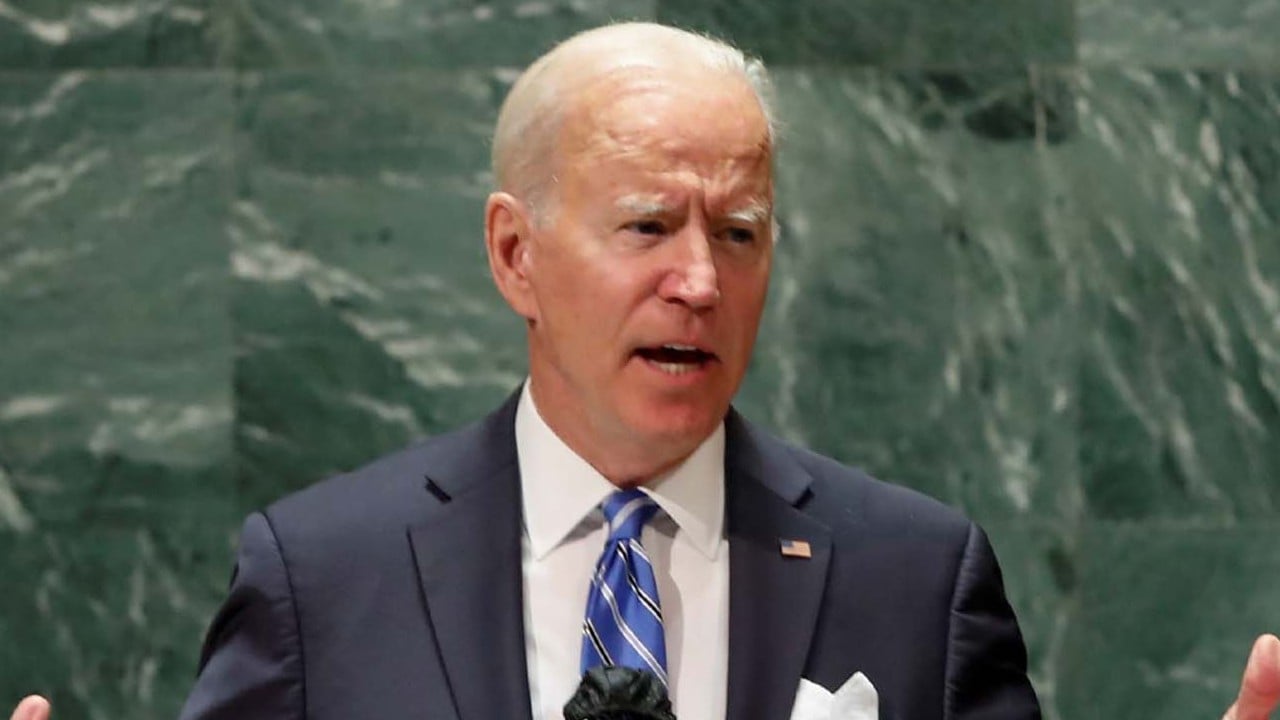
How is Xinjiang still shipping millions of goods to US after ‘forced labour’ law came into effect?
- Xinjiang entities exported a 10-month high of US$56.8 million of goods to the US in August despite the Uygur Forced Labour Prevention Act being in place since June
- Act assumes that all goods from Xinjiang are at risk of being tainted by forced labour, despite repeated denials from Beijing
On the 29th of August, at the height of the busy import season before America’s annual holiday shopping boom, a crate of T-shirts and toys arrived at the Port of Long Beach in California after a journey of thousands of miles from Yantian Port in Southern China.
The 21kg of shirts (46lbs) and 3kg (6.6lbs) of toys were on their way to Massachusetts and New York – two almost negligible entries among the billions of dollars in US-China trade every year.
But they were both shipped from the same unexpected place: the Xinjiang Uygur autonomous region.
Chinese customs data showed that Xinjiang entities exported US$56.8 million worth of goods to the US in August, surging to their highest level in 10 months, and appearing for the second consecutive month to defy the new law.
The value more than doubled that of July – the first full month after the Uygur Forced Labour Prevention Act went into effect – and was almost sevenfold of that in June. It also surged 592.8 per cent compared to a year earlier.
With the apparent jump in exports, the US became the far-west region’s fifth biggest trading partner in August, following three neighbouring Central Asian countries and Russia, up from 12th in July.
The surge in trade reported from Xinjiang also bucked the overall trend of weakening Chinese exports to the US, which recorded a year-on-year decline in August for the first time since May 2020.
CBP probably needs to do more, especially to address all of the different modes that these goods might potentially be using to circumvent inspection and detention
For the second month in a row, the figure surprised industry observers in both countries, who expected it would plummet to zero after the law took effect. They described the result as “really odd”, while also cautioning that the apparent rise in exports does not necessarily mean all of these shipments have entered US territory.
“I think that [Customs and Border Protection] hasn’t quite hit their stride on detentions yet,” said Ana Hinojosa, a former executive director for trade remedy law enforcement at US Customs and Border Protection (CBP), which is tasked with enforcing the regulation.
“CBP probably needs to do more, especially to address all of the different modes that these goods might potentially be using to circumvent inspection and detention.”
The US customs agency said it would not comment on data provided by other countries.
According to China’s customs records, Christmas goods remained the top individual product exported to the US for two months in a row, worth US$4.8 million in August, followed by toys, totalling US$2.5 million.
Apparel shipments to the US – already flagged by officials in Washington as a category of particular concern for potential forced labour – added up to more than US$9 million, the highest value since October 2020, and accounting for 16 per cent of the region’s total exports to the US last month.
That included nearly 8 million pairs of socks, and hundreds of thousands of shirts, trousers, jackets and dresses.
Olga Torres, founder and managing member of the Washington-based Torres Law that specialises in trade and national security, said that either US Customs is overwhelmed and not stopping everything, or that the Chinese numbers may not be correct.
Boon or burden? Asian alternatives to Xinjiang cotton find US ban challenging
“At this point, I don’t think people would be shipping more if they can’t meet the burden of proof [required by the law],” she said.
The act assumes that all goods from Xinjiang are at risk of being tainted by forced labour, and creates a “rebuttable presumption” that bans US imports of any materials produced in the region unless the importers can prove otherwise. Beijing has repeatedly denied all the allegations of forced labour.
Companies can appeal if they can provide “clear and convincing” evidence to US customs authorities that their supply chains are free of forced labour, but meeting the requirements will be extremely difficult, if not impossible, lawyers said, due to the opaqueness of the region and how difficult it would be for auditors to conduct meaningful inspections.

According to shipping records provided by trade database ImportGenius, cargo from Xinjiang arriving in the US after the new law took effect included T-shirts and toys – like the two packages in the same container at the end of last month – as well as backpacks, wool jumpers, faux marble sinks and tools used for drilling.
They also included 48 tonnes of cotton wrap from Shihezi – a region controlled by the quasi-military Xinjiang Production and Construction Corps, which was sanctioned by the US in 2020.
Kevin Cai Kaiming, a senior partner at Dentons law firm in Beijing, said the trade data may imply that “the US is still open to [Xinjiang] products that have actual demand”. Cai is also the deputy director of the trade and economics expert committee at the China Council for the Promotion of International Trade.
But Michael Roll, a customs and trade lawyer in Los Angeles at Roll and Harris, said the data only showed China’s exports, and not what the US actually let in through its borders.
If CBP sees the goods coming from a Xinjiang manufacturer – US importers of textiles or apparel do have to report the manufacturer – I would bet those goods are being stopped per the [act]
“One would expect the numbers to go in the other direction,” Roll said.
“But if CBP sees the goods coming from a Xinjiang manufacturer – US importers of textiles or apparel do have to report the manufacturer – I would bet those goods are being stopped per the [act].”
Hinojosa, the former US customs official, said the exports might also possibly include individual garments bought by Americans on e-commerce platforms, as opposed to bulk shipments for clothing chains and other retailers.
“If it’s a large container, that’s going to be a little bit easier to track,” she added. “But if it’s two shirts in a bag, or a tube top in a bag, that’s either going through the mail or going through one of the express carriers, it’s going to be more difficult for them to target those.
“There’s so many of them that the value of them could easily reach the numbers [shown in the Chinese data].”
According to Chinese customs records, Xinjiang exported just 45 unidentified items to the US via e-commerce in August, worth US$3,786.
China’s General Administration of Customs and Ministry of Commerce both did not respond to requests for comment.
Roy Liu, a partner at the Washington law firm Hughes Hubbard & Reed, said the export data will increase lawmakers’ scrutiny of the US customs agency’s enforcement of the law.
“Such scrutiny already is substantial,” Liu said, referring to a letter sent earlier this month by a group of US lawmakers to the customs agency and the US Treasury Department’s Office of Foreign Assets Control, which oversees US economic sanctions, concerning the enforcement of the act.
The lawmakers focused on red jujube dates, a speciality of Xinjiang that can often be found in Asian supermarkets in the US, after a recent investigation by the Washington-based Uygur Human Rights Project detailed the fruit’s links to potential forced labour in the region.
‘Barely a boost’: China to buy Xinjiang cotton as US ban hits home for mills
“It is also possible that US Customs will be pressured to release more data on the volume of detentions related to the act, which may shed light on how much of the volume actually did not enter the US market,” Liu added.
According to US Customs, in August, the agency targeted 838 entries valued at more than US$266.5 million for suspected use of forced labour in the production of imported goods, including those subject to the new law.
US Customs has identified four “high-risk” sectors that it said will be scrutinised under the law, including apparel, cotton, tomatoes and polysilicon – a material crucial to solar panel production.
Even though all products with potential links to Xinjiang are effectively banned under the act, lawyers said enforcement in the short term is likely to focus on the four industries, along with Xinjiang-linked companies named on the customs agency’s so-called entity list.
The customs agency has also received additional funding from the US Congress to enforce the law, but experts said it could take months to hire and train new staff.
Overall, Xinjiang’s global exports reached an all-time high in August, according to Wu Wei, deputy director of Urumqi Customs, with shipments totalling of US$3.8 billion, official data showed.
The export value rose by 112.9 per cent year on year, despite widespread coronavirus-related lockdowns in the region.
But Xinjiang’s trade flows are far shallower compared to the rest of China, which contributes to the relative volatility in the year-on-year export growth rates, trade experts said.
How the US’ Xinjiang labour law leaves millions of tonnes of cotton unsold
Over 82 per cent of Xinjiang’s exports are labour-intensive products, as well as mechanical and electrical products, Wu said during a press conference earlier this month.
“The structure of Xinjiang’s foreign trade commodities has been steadily optimised,” he said.
“Benefiting from the growing demand in European markets and the development of the Central Asian market, the new energy industry continues to maintain a good momentum of rapid export growth.”




